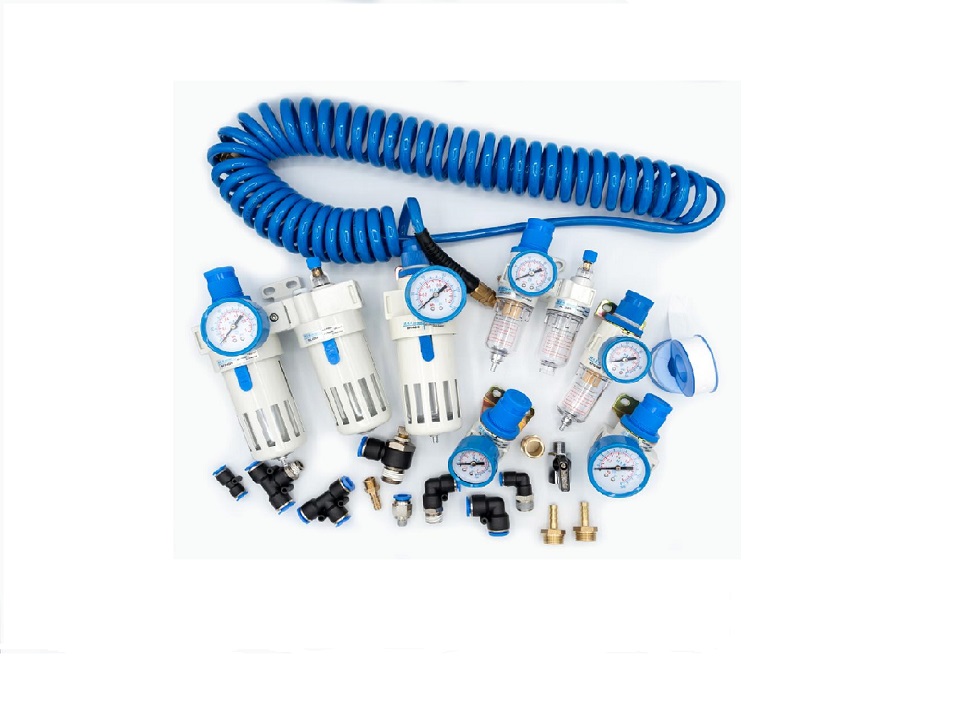Pneumatic systems play a crucial role in various industrial applications, powering machinery and equipment with the force of compressed air. However, the quality and consistency of the tight air supply are essential for optimal performance and longevity of these systems. That's where the Filter-Regulator-Lubricator (FRL) comes into play. The FRL is vital in pneumatic systems, ensuring the compressed air is clean, regulated, and adequately lubricated.
By performing three essential functions—filtration, regulation, and lubrication—the FRL plays a pivotal role in maintaining pneumatic systems' efficiency, reliability, and longevity. In this outline, we will explore each of these functions in detail, emphasizing their significance and impact on the overall performance of pneumatic systems.
The three functions of an FRL
- Air filtration: The first step in the FRL process is air filtration. The compressed air is thoroughly cleansed by specialized filters, trapping solid particles such as dust, dirt, and rust. This step is essential as even the tiniest particles can harm the performance of various pneumatic tools and equipment. Dust accumulation within an engine, for example, can obstruct the airflow, leading to reduced power output and increased air consumption. Additionally, dirt and rust can cause engine damage, resulting in power loss and premature wear. By effectively filtering the compressed air, the risk of tool malfunctions, elevated maintenance expenses, and production disruptions can be significantly minimized.
- Air regulation: The second step in the FRL process is air regulation. A regulator maintains a consistent dynamic working pressure at a specified level, typically around 90 psi/6.3 bar. This step is vital because operating pneumatic tools below the recommended pressure level can prevent them from reaching their optimal performance levels, thus reducing overall productivity and profitability. On the other hand, if the pressure is set too high, it can accelerate wear and tear on the tools, potentially causing breakdowns, operator injuries, and damage to the application. By precisely regulating the pressure, the FRL system ensures that pneumatic tools operate within their intended performance range, optimizing efficiency and mitigating potential risks.
- Air lubrication: The final step in the FRL process is air lubrication. Using a lubricator, controlled quantities of oil are introduced into the compressed air system. This step is crucial for ensuring pneumatic tools and equipment's smooth and efficient operation. With proper lubrication, the moving components within the devices can experience more friction and wear, leading to reduced performance, increased maintenance requirements, and decreased service life. By providing a consistent and controlled supply of lubricating oil, the FRL system ensures that the tools can operate at their maximum potential, minimizing downtime, enhancing productivity, and reducing long-term maintenance costs.
FRL Air Treatment is a critical aspect of pneumatic system design and operation. It is commonly used in various industries, including manufacturing, automotive, food processing, pharmaceuticals, etc. Proper selection, installation, and maintenance of FRL units are essential for optimal air quality and system performance. Regular monitoring and replacement of filter elements, as well as adjusting the regulator and lubricator settings as needed, are crucial for maintaining the effectiveness of FRL air treatment and the overall reliability of the pneumatic system.
How to choose the correct FRL Air Treatment Unit?
Choosing the correct FRL Air Treatment unit is crucial to ensure optimal performance and longevity of pneumatic systems. Here are three tips to help you make the right choice:
- Consider your application requirements: Evaluate the specific needs of your pneumatic application. Consider factors such as the required flow rate, operating pressure range, and the type and level of contaminants in the compressed air. This information will guide you in selecting an FRL unit with the appropriate filtration rating, pressure range, and capacity to handle the specific demands of your application.
- Assess the environment and conditions: Consider the environmental conditions where the FRL unit will be installed. Consider factors such as temperature, humidity, presence of corrosive substances, and potential exposure to harsh elements. Choose an FRL unit designed to withstand these conditions and has appropriate corrosion resistance and sealing capabilities. Additionally, if your application requires specific certifications or compliance with industry standards, ensure that the selected FRL unit meets those requirements.
- Consider maintenance and ease of service: Regular maintenance is crucial for the proper functioning of an FRL unit. Consider the ease of maintenance and availability of replacement parts when selecting an FRL unit. Look for units that have easily accessible filter elements, transparent indicator systems for maintenance intervals, and convenient methods for replacing filters, regulators, and lubricators. This will help ensure that maintenance tasks such as filter element replacement, pressure adjustments, and lubricator refills can be carried out efficiently, minimizing downtime and maximizing the lifespan of the FRL unit.
By considering your application requirements, environmental conditions, and maintenance needs, you can choose the correct FRL Air Treatment unit that best suits your specific pneumatic system, ensuring optimal air quality, performance, and longevity. For further information or to discuss your needs, please contact us.

